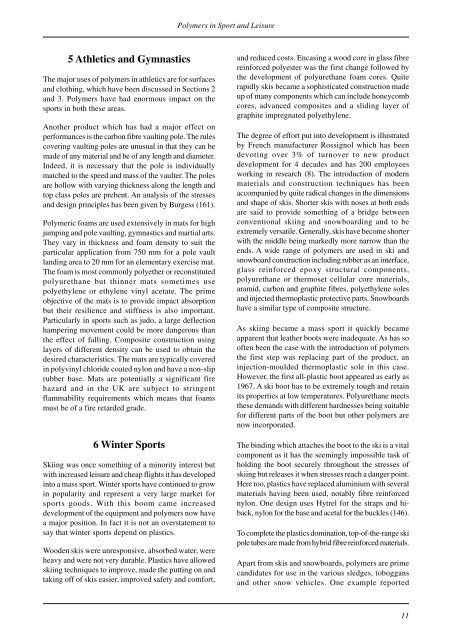Polymers in Sport and Leisure
Polymers in Sport and Leisure
Polymers in Sport and Leisure
You also want an ePaper? Increase the reach of your titles
YUMPU automatically turns print PDFs into web optimized ePapers that Google loves.
<strong>Polymers</strong> <strong>in</strong> <strong>Sport</strong> <strong>and</strong> <strong>Leisure</strong><br />
5 Athletics <strong>and</strong> Gymnastics<br />
The major uses of polymers <strong>in</strong> athletics are for surfaces<br />
<strong>and</strong> cloth<strong>in</strong>g, which have been discussed <strong>in</strong> Sections 2<br />
<strong>and</strong> 3. <strong>Polymers</strong> have had enormous impact on the<br />
sports <strong>in</strong> both these areas.<br />
Another product which has had a major effect on<br />
performances is the carbon fibre vault<strong>in</strong>g pole. The rules<br />
cover<strong>in</strong>g vault<strong>in</strong>g poles are unusual <strong>in</strong> that they can be<br />
made of any material <strong>and</strong> be of any length <strong>and</strong> diameter.<br />
Indeed, it is necessary that the pole is <strong>in</strong>dividually<br />
matched to the speed <strong>and</strong> mass of the vaulter. The poles<br />
are hollow with vary<strong>in</strong>g thickness along the length <strong>and</strong><br />
top class poles are prebent. An analysis of the stresses<br />
<strong>and</strong> design pr<strong>in</strong>ciples has been given by Burgess (161).<br />
Polymeric foams are used extensively <strong>in</strong> mats for high<br />
jump<strong>in</strong>g <strong>and</strong> pole vault<strong>in</strong>g, gymnastics <strong>and</strong> martial arts.<br />
They vary <strong>in</strong> thickness <strong>and</strong> foam density to suit the<br />
particular application from 750 mm for a pole vault<br />
l<strong>and</strong><strong>in</strong>g area to 20 mm for an elementary exercise mat.<br />
The foam is most commonly polyether or reconstituted<br />
polyurethane but th<strong>in</strong>ner mats sometimes use<br />
polyethylene or ethylene v<strong>in</strong>yl acetate. The prime<br />
objective of the mats is to provide impact absorption<br />
but their resilience <strong>and</strong> stiffness is also important.<br />
Particularly <strong>in</strong> sports such as judo, a large deflection<br />
hamper<strong>in</strong>g movement could be more dangerous than<br />
the effect of fall<strong>in</strong>g. Composite construction us<strong>in</strong>g<br />
layers of different density can be used to obta<strong>in</strong> the<br />
desired characteristics. The mats are typically covered<br />
<strong>in</strong> polyv<strong>in</strong>yl chloride coated nylon <strong>and</strong> have a non-slip<br />
rubber base. Mats are potentially a significant fire<br />
hazard <strong>and</strong> <strong>in</strong> the UK are subject to str<strong>in</strong>gent<br />
flammability requirements which means that foams<br />
must be of a fire retarded grade.<br />
6 W<strong>in</strong>ter <strong>Sport</strong>s<br />
Ski<strong>in</strong>g was once someth<strong>in</strong>g of a m<strong>in</strong>ority <strong>in</strong>terest but<br />
with <strong>in</strong>creased leisure <strong>and</strong> cheap flights it has developed<br />
<strong>in</strong>to a mass sport. W<strong>in</strong>ter sports have cont<strong>in</strong>ued to grow<br />
<strong>in</strong> popularity <strong>and</strong> represent a very large market for<br />
sports goods. With this boom came <strong>in</strong>creased<br />
development of the equipment <strong>and</strong> polymers now have<br />
a major position. In fact it is not an overstatement to<br />
say that w<strong>in</strong>ter sports depend on plastics.<br />
Wooden skis were unresponsive, absorbed water, were<br />
heavy <strong>and</strong> were not very durable. Plastics have allowed<br />
ski<strong>in</strong>g techniques to improve, made the putt<strong>in</strong>g on <strong>and</strong><br />
tak<strong>in</strong>g off of skis easier, improved safety <strong>and</strong> comfort,<br />
<strong>and</strong> reduced costs. Encas<strong>in</strong>g a wood core <strong>in</strong> glass fibre<br />
re<strong>in</strong>forced polyester was the first change followed by<br />
the development of polyurethane foam cores. Quite<br />
rapidly skis became a sophisticated construction made<br />
up of many components which can <strong>in</strong>clude honeycomb<br />
cores, advanced composites <strong>and</strong> a slid<strong>in</strong>g layer of<br />
graphite impregnated polyethylene.<br />
The degree of effort put <strong>in</strong>to development is illustrated<br />
by French manufacturer Rossignol which has been<br />
devot<strong>in</strong>g over 3% of turnover to new product<br />
development for 4 decades <strong>and</strong> has 200 employees<br />
work<strong>in</strong>g <strong>in</strong> research (8). The <strong>in</strong>troduction of modern<br />
materials <strong>and</strong> construction techniques has been<br />
accompanied by quite radical changes <strong>in</strong> the dimensions<br />
<strong>and</strong> shape of skis. Shorter skis with noses at both ends<br />
are said to provide someth<strong>in</strong>g of a bridge between<br />
conventional ski<strong>in</strong>g <strong>and</strong> snowboard<strong>in</strong>g <strong>and</strong> to be<br />
extremely versatile. Generally, skis have become shorter<br />
with the middle be<strong>in</strong>g markedly more narrow than the<br />
ends. A wide range of polymers are used <strong>in</strong> ski <strong>and</strong><br />
snowboard construction <strong>in</strong>clud<strong>in</strong>g rubber as an <strong>in</strong>terface,<br />
glass re<strong>in</strong>forced epoxy structural components,<br />
polyurethane or thermoset cellular core materials,<br />
aramid, carbon <strong>and</strong> graphite fibres, polyethylene soles<br />
<strong>and</strong> <strong>in</strong>jected thermoplastic protective parts. Snowboards<br />
have a similar type of composite structure.<br />
As ski<strong>in</strong>g became a mass sport it quickly became<br />
apparent that leather boots were <strong>in</strong>adequate. As has so<br />
often been the case with the <strong>in</strong>troduction of polymers<br />
the first step was replac<strong>in</strong>g part of the product, an<br />
<strong>in</strong>jection-moulded thermoplastic sole <strong>in</strong> this case.<br />
However, the first all-plastic boot appeared as early as<br />
1967. A ski boot has to be extremely tough <strong>and</strong> reta<strong>in</strong><br />
its properties at low temperatures. Polyurethane meets<br />
these dem<strong>and</strong>s with different hardnesses be<strong>in</strong>g suitable<br />
for different parts of the boot but other polymers are<br />
now <strong>in</strong>corporated.<br />
The b<strong>in</strong>d<strong>in</strong>g which attaches the boot to the ski is a vital<br />
component as it has the seem<strong>in</strong>gly impossible task of<br />
hold<strong>in</strong>g the boot securely throughout the stresses of<br />
ski<strong>in</strong>g but releases it when stresses reach a danger po<strong>in</strong>t.<br />
Here too, plastics have replaced alum<strong>in</strong>ium with several<br />
materials hav<strong>in</strong>g been used, notably fibre re<strong>in</strong>forced<br />
nylon. One design uses Hytrel for the straps <strong>and</strong> hiback,<br />
nylon for the base <strong>and</strong> acetal for the buckles (146).<br />
To complete the plastics dom<strong>in</strong>ation, top-of-the-range ski<br />
pole tubes are made from hybrid fibre re<strong>in</strong>forced materials.<br />
Apart from skis <strong>and</strong> snowboards, polymers are prime<br />
c<strong>and</strong>idates for use <strong>in</strong> the various sledges, toboggans<br />
<strong>and</strong> other snow vehicles. One example reported<br />
11










